Комета ISON, судя по всему, не выдержала сближения с Солнцем, полностью испарилась и больше никогда не появится на небе. На снимках космических телескопов после сближения кометы со звездой появилось только слабое облачко. Сегодня вечером, в 22:45, «комета века» должна была пролететь в 1,16 млн километров от поверхности Солнца, но еще до этого момента, как оказалось, ядро кометы разрушилось, превратившись в пыль.
В поле зрения солнечной обсерватории SDO, которая должна была зафиксировать момент прохождения кометы рядом с Солнцем, она уже не появилась. «Как Икар, она, возможно, пролетела слишком близко к Солнцу», — отмечается в сообщении НАСА.
-
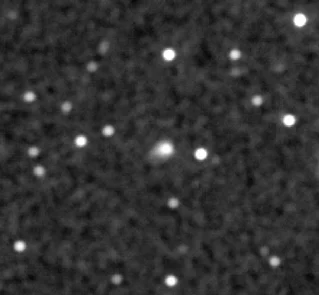
The Ultraviolet/Optical Telescope aboard NASA's Swift imaged Comet ISON (center) on Jan. 30, when it was located about 3.3 degrees from the bright star Castor in the constellation Gemini. At the time of this 5.5-minute optical exposure, ISON was about 5,000 times fainter than the limit of human vision and was located 375 million miles (604 million km) from Earth and 460 million miles (740 million km) from the sun. Credit: NASA/Swift/D. Bodewits, UMCP
-
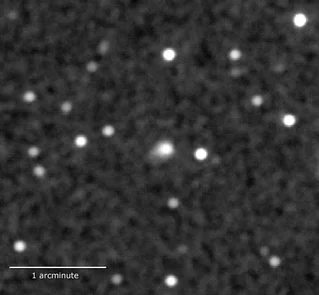
The Ultraviolet/Optical Telescope aboard NASA's Swift imaged Comet ISON (center) on Jan. 30, when it was located about 3.3 degrees from the bright star Castor in the constellation Gemini. At the time of this 5.5-minute optical exposure, ISON was about 5,000 times fainter than the limit of human vision and was located 375 million miles (604 million km) from Earth and 460 million miles (740 million km) from the sun. Credit: NASA/Swift/D. Bodewits, UMCP
-
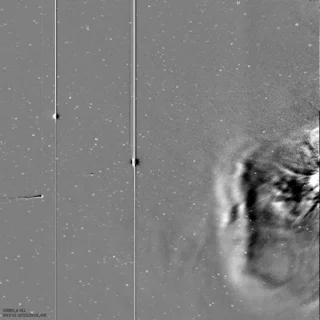
This still image from the video shows comet ISON just passing the plane of Mercury, with Comet Encke ahead and slightly above on Nov. 22, 2013. The sun is off-screen to the right. The wave-like shape on the right is a coronal mass ejection (CME.) Image Credit:Karl Battams/NRL/NASA STEREO/CIOC
-
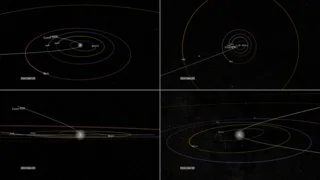
Still of all four views of ISON orbital path.
-
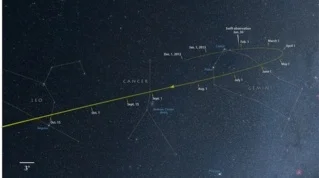
From now through October, Comet ISON tracks through the constellations Gemini, Cancer and Leo as it falls toward the sun. Credit: NASA's Goddard Space Flight Center/Axel Mellinger, Central Michigan Univ.
-
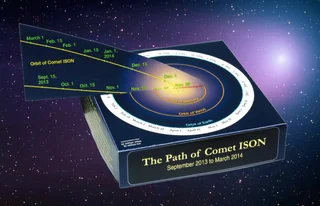
This paper model illustrates the comet's path during its six-month trek in the vicinity of Earth, Venus and Mercury. Track how the relationship between Earth and the comet constantly changes by referring to the dates along both orbits.
-
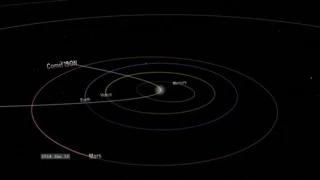
Comet ISON is now approaching the inner solar system. Discovered last year, the comet remains unusually active for its distance from the sun. If current trends continue, ISON could rank as one of the brightest comets in decades when it makes its close approach to the sun in late November. This animation shows the comet's approach and departure from the inner solar system from various perspectives. Credit: NASA's Goddard Space Flight Center Scientific Visualization Studio
-
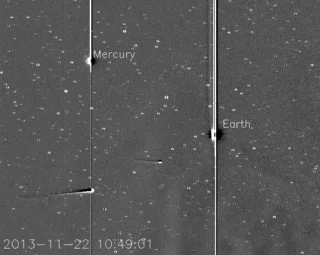
NASA's STEREO-A spacecraft is monitoring Comet ISON as it approaches the sun. The latest movie from the spacecraft's Heliospheric Imager shows Comet ISON, Mercury, Comet Encke and Earth over a two day period from Nov. 20 to Nov. 22, 2013. The sun sits right of the field of view of this camera. Image Credit: Karl Battams/NRL/NASA STEREO/CIOC.
-
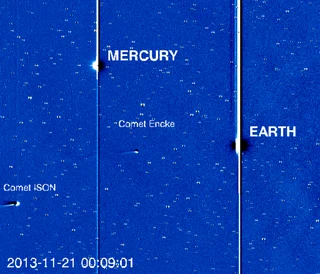
Comet ISON makes its appearance into the higher-resolution HI-1 camera on the STEREO-A spacecraft. The dark "clouds" coming from the right are density enhancements in the solar wind, causing all the ripples in comet Encke's tail. These kinds of solar wind interactions give us valuable information about solar wind conditions near the sun. Note: the STEREO-A spacecraft is currently located on the other side of the Sun, so it sees a totally different geometry to what we see from Earth. Credit: Karl Battams/NASA/STEREO/CIOC
-
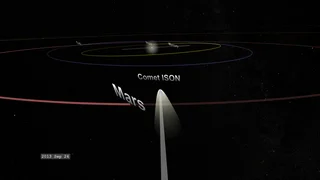
This animation shows two views of comet ISON's path through the inner solar system. The first is a view following the comet along its orbit. The second is a view perpendicular to ISON's orbit. Credit: NASA's Goddard Space Flight Center Scientific Visualization Studio
-
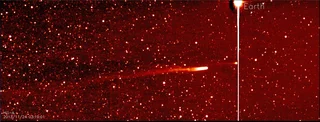
Cropped and enlarged footage from the STEREO A Hi 1 sensor covering Nov 21 at 0:39UT to Nov 25 at 15:19 UT.The sun sits right of the field of view of this camera. Credit: Nathan Rich/NRL/NASA STEREO/CIOC.
-
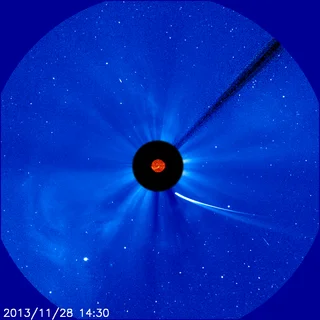
Comet ISON moves ever closer to the sun in this image from ESA and NASA's Solar and Heliospheric Observatory, or SOHO, captured at 9:30 a.m. EST on Nov. 28, 2013. This image is a composite, with the sun imaged by NASA's Solar Dynamics Observatory, or SDO, in the center, and SOHO showing the solar atmosphere, the corona. Credit: ESA
-
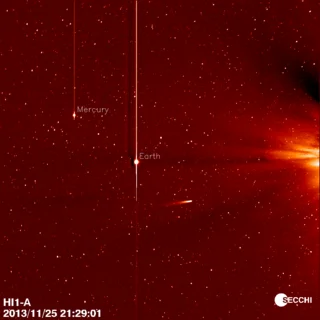
NASA's STEREO-A spacecraft continues to observe Comet ISON as it approaches the sun. This movie from the spacecraft's Heliospheric Imager shows Comet ISON, Mercury, Comet Encke and Earth over a five day period from Nov. 20 to Nov. 25, 2013. The sun sits right of the field of view of this camera. This is the full-resolution, full field-of-view. It covers the same time period as the video above and has a time stamp. Credit: NRL/NASA STEREO/CIOC.
-
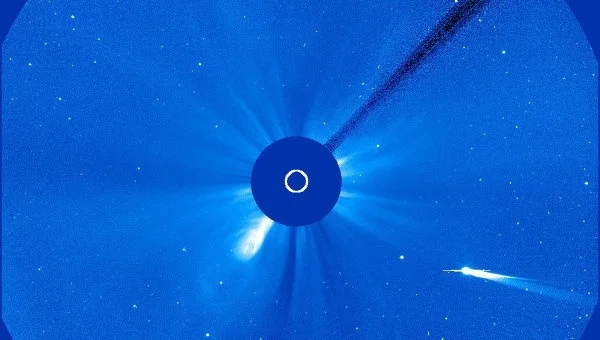
Comet ISON moves ever closer to the sun in this image from ESA and NASA's Solar and Heliospheric Observatory, or SOHO, captured at 9:30 a.m. EST on Nov. 28, 2013. This image is a composite, with the sun imaged by NASA's Solar Dynamics Observatory, or SDO, in the center, and SOHO showing the solar atmosphere, the corona. Credit: ESA
-
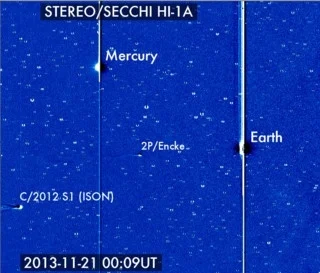
Comet C/2012 S1 (ISON) has entered the NASA STEREO/SECCHI HI-1A field of view where it joins the Earth, Mercury and comet 2P/Encke. Credit: Karl Battams/NASA/STEREO/CIOC
-
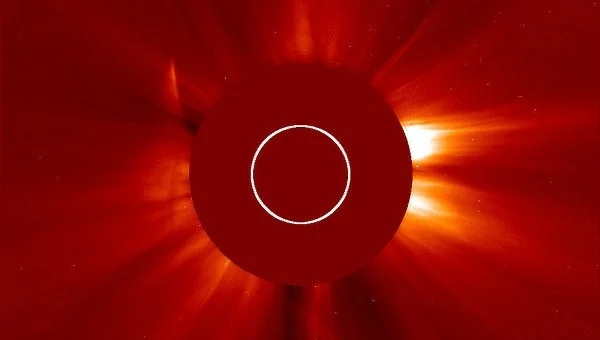
These images from NASA's Solar Terrestrial Relations Observatory and the ESA/NASA Solar and Heliospheric Observatory show Comet ISON growing dim as it made the journey around the sun. The comet is believed to have broken up and evaporated. Credit: NASA/SDO/ESA/SOHO/GSFC
-
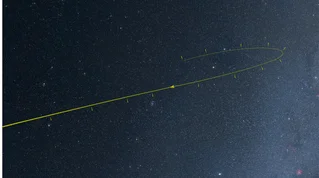
From now through October, Comet ISON tracks through the constellations Gemini, Cancer and Leo as it falls toward the sun. No Labels. Credit: NASA's Goddard Space Flight Center/Axel Mellinger, Central Michigan Univ.
-
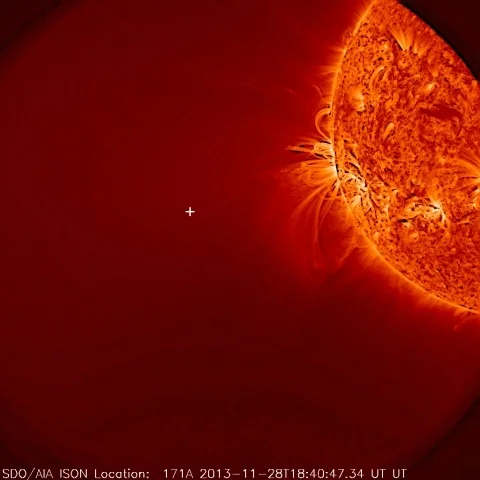
This image from NASA's Solar Dynamics Observatory shows the sun, but no Comet ISON was seen. A white plus sign shows where the Comet should have appeared. It is likely that the comet did not survive the trip. Image Credit: NASA/SDO
-
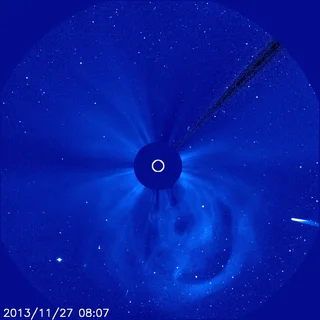
ISON enters the field of view of the joint ESA/NASA Solar and Heliospheric Observatory, or SOHO, spacecraft's C3 coronograph, where the brighter view of the sun itself is blocked to focus on the solar atmosphere, or corona. This video covers 17 hours beginning at 19:42 UT on Nov. 26, 2013. Full-resolution, full-field frames, video at 6fps and still. Credit: ESA
-
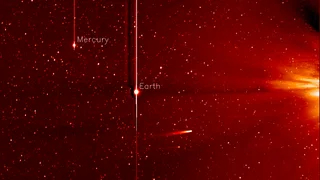
NASA's STEREO-A spacecraft continues to observe Comet ISON as it approaches the sun. This movie from the spacecraft's Heliospheric Imager shows Comet ISON, Mercury, Comet Encke and Earth over a five day period from Nov. 20 to Nov. 25, 2013. The sun sits right of the field of view of this camera. This version is enhanced, resized and cropped for HD. Credit: NASA/NRL/STEREO/CIOC/GSFC.
-
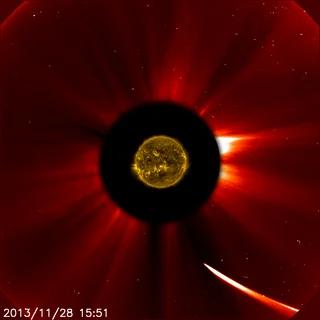
Comet ISON has moved quite close to the sun in this image from ESA/NASA's Solar and Heliospheric Observatory captured at 10:51 a.m. EST on Nov. 28, 2013. This image is a composite, with the sun imaged by NASA's Solar Dynamics Observatory in the center, and SOHO showing the solar atmosphere, the corona. Image Credit: ESA
-
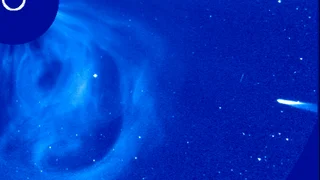
SON enters the field of view of the joint ESA/NASA Solar and Heliospheric Observatory, or SOHO, spacecraft's C3 coronograph, where the brighter view of the sun itself is blocked to focus on the solar atmosphere, or corona. This video covers 17 hours beginning at 19:42 UT on Nov. 26, 2013. Credit: ESA
«Это печально, что она разрушилась, — отметил астроном Фил Плэйт в ходе телеконференции НАСА. — Но с точки зрения науки, это замечательно: при распаде кометы высвободились вещества, из которых она состояла, и теперь мы можем узнать больше о той материи, из которой образовалась солнечная система».

Комета C/2012 S1 (ISON) была открыта в сентябре 2012 года Артемом Новичонком и Виталием Невским в ходе наблюдений на обсерватории близ Кисловодска, входящей в международную сеть обсерваторий ISON. Именно в честь этой сети комета и получила свое название. Авторы открытия и другие астрономы почти сразу отметили, что комета должна пройти очень близко к Солнцу, а затем относительно недалеко от Земли. Таким образом, она должна была стать одной из крупнейших «солнцецарапающих комет», а значит, ее появление на земном небе обещало быть очень ярким. Однако этого не произошло: комета разрушилась от Солнца раньше этого момента.
-
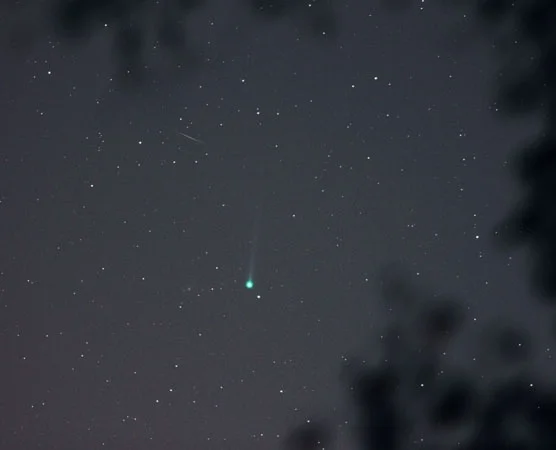
Комета ISON Фото skyandtelescope.com
-
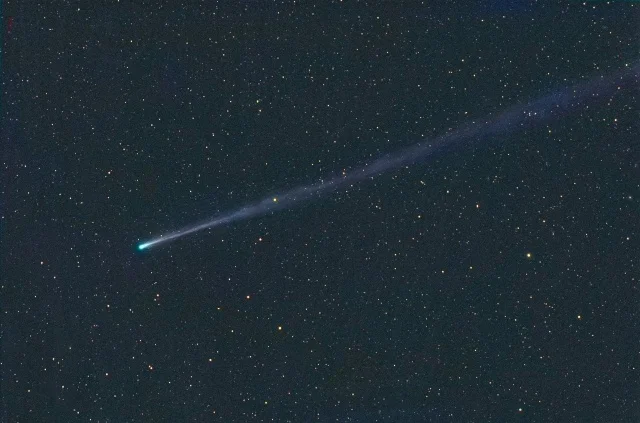
Комета ISON Фото skyandtelescope.com
-
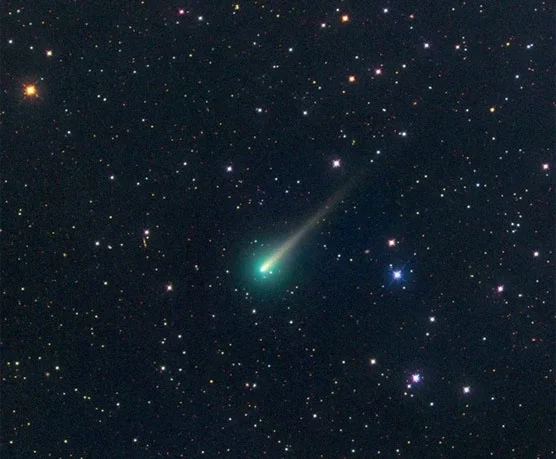
Комета ISON Фото skyandtelescope.com
-
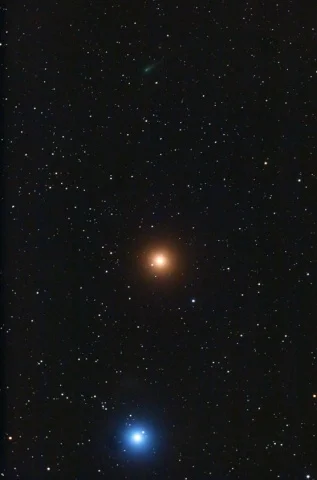
Комета ISON Фото skyandtelescope.com
«Ядро кометы окончательно развалилось, скорее всего, из-за Солнца вылетит уже шлейф обломков и пыли, — рассказал агентству РИА «Новости» научный руководитель обсерватории «Ка-Дар» Станислав Короткий. — Яркого зрелища на утреннем небе в декабре ждать не стоит, но слабоконтрастный хвост может появиться».
-
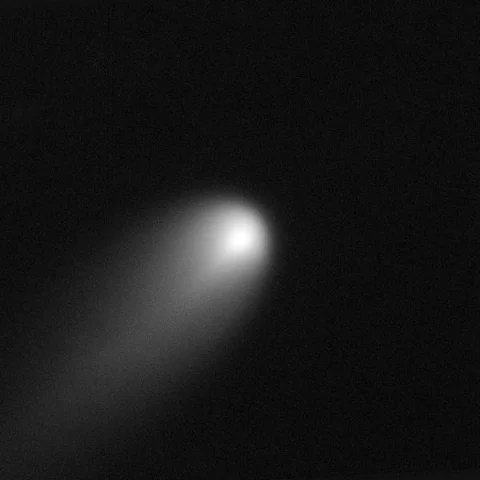
Nasa. Hubble
-
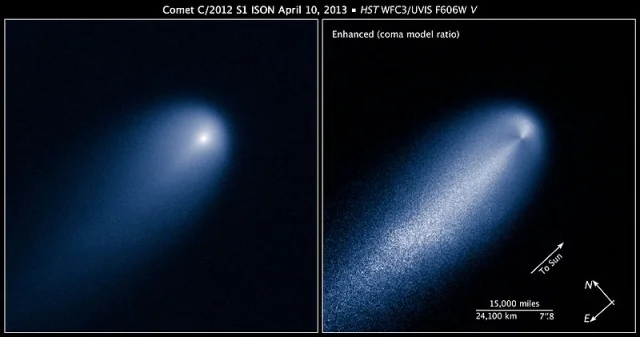
Nasa. Hubble
-
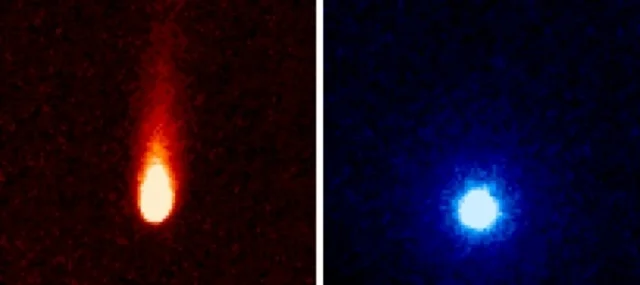
Nasa. Spitzer